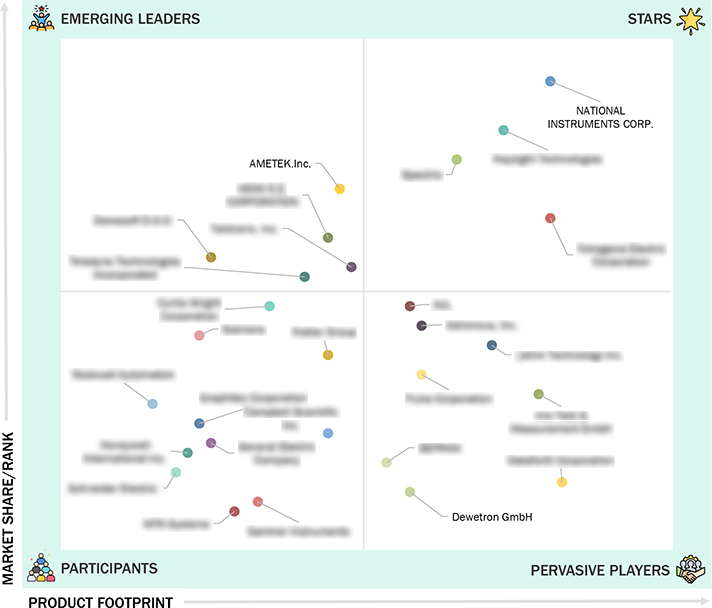Comparing 26 vendors in Data Acquisition System across 67 criteria.
The Data Acquisition (DAQ) System Companies Quadrant is a comprehensive industry analysis that provides valuable insights into the global market for Data Acquisition (DAQ) System. This quadrant offers a detailed evaluation of key market players, technological advancements, product innovations, and emerging trends shaping the industry. MarketsandMarkets 360 Quadrants evaluated over 100 companies, of which the Top 28 Data Acquisition (DAQ) System Companies were categorized and recognized as quadrant leaders.
Market Leadership Quadrant
1.1 Study Objectives
1.2 Market Definition
1.3 Study Scope
1.3.1 Markets Covered and Regional Scope
1.3.2 Inclusions and Exclusions
1.3.3 Years Considered
1.4 Currency Considered
1.5 Unit Considered
1.6 Limitations
1.7 Stakeholders
1.8 Summary of Changes
2.1 Introduction
2.2 Market Dynamics
2.2.1 Drivers
2.2.1.1 Rising importance of data monitoring in improving
industrial efficiency
2.3 technologies
2.3.1.1 Rising integration of advanced technologies into modern DAQ
systems
2.3.2 Restraints
2.3.2.1 Requirement for high computational power for real-time data
analysis
2.3.2.2 Price sensitivity among consumers
2.3.3 Opportunities
2.3.3.1 Shifting preference toward automated DAQ systems
2.3.3.2 Surging demand for high-speed connectivity technologies in
industries
2.3.4 Challenges
2.3.4.1 Regulatory and compliance constraints
2.3.4.2 Increasing cybersecurity risks
2.4 Value Chain Analysis
2.5 Ecosystem Analysis
2.6 Investment and Funding Scenario
2.7 Trends/Disruptions Impacting Customer Business
2.8 Technology Analysis
2.8.1 Key Technologies
2.8.1.1 Digital twins
2.8.1.2 Internet of Things (IoT)
2.8.2 Complementary Technologies
2.8.3 Adjacent Technologies
2.8.3.1 Industrial data management
2.8.3.2 Process analytics
2.9 Porter’s Five Forces Analysis
2.9.1 Intensity of Competitive Rivalry
2.9.2 Bargaining Power of Suppliers
2.9.3 Bargaining Power of Buyers
2.9.4 Threat of Substitutes
2.9.5 Threat of New Entrants
2.10 Key Conferences and Events, 2025–2026
2.11 Impact of AI/Gen AI on Data Acquisition (DAQ) System Market
2.11.1 Introduction
2.11.2 Impact of AI/Gen AI on DAQ Applications
2.12 Impact of Cybersecurity on Data Acquisition (DAQ) System Market
2.13 Impact of US Tariff on Data Acquisition (DAQ) System Market
2.13.1 Introduction
2.13.2 Key Tariff Rates
2.13.3 Price Impact Analysis
2.13.4 Impact on Country/Region
2.13.4.1 US
2.13.4.2 Europe
2.13.4.3 Asia Pacific
2.13.5 Impact on Verticals
3.1 Overview
3.2 Key Player Strategies/Right to Win, 2021–2025
3.3 Revenue Analysis, 2020–2024
3.4 Market Share Analysis, 2o24
3.5 Company Valuation and Financial Metrics
3.6 Brand Comparison
3.7 Company Evaluation Matrix: Key Players, 2024
3.7.1 Stars
3.7.2 Emerging Leaders
3.7.3 Pervasive Players
3.7.4 Participants
3.7.5 Company Footprint: Key Players, 2024
3.7.5.1 Company footprint
3.7.5.2 Region footprint
3.7.5.3 Offering footprint
3.7.5.4 Speed footprint
3.7.5.5 Application footprint
3.7.5.6 Vertical footprint
3.8 Competitive Scenario
3.8.1 Product Launches
4.1 NATIONAL INSTRUMENTS CORP.
4.1.1 Business overview
4.1.2 Products/Solutions/Services offered
4.1.3 Recent developments
4.2 KEYSIGHT TECHNOLOGIES
4.2.1 Business overview
4.2.2 Products/Solutions/Services offered
4.2.3 Recent developments
4.3 DEWETRON GMBH
4.3.1 Business overview
4.3.2 Products/Solutions/Services offered
4.3.3 Recent developments
4.4 AMETEK.INC.
4.4.1 Business overview
4.4.2 Products/Solutions/Services offered
4.4.3 Recent developments
4.5 YOKOGAWA ELECTRIC CORPORATION
4.5.1 Business overview
4.5.2 Products/Solutions/Services offered
4.5.3 Recent developments
4.6 TEKTRONIX, INC.
4.6.1 Business overview
4.6.2 Products/Solutions/Services offered
4.6.3 Recent developments
4.7 ADLINK TECHNOLOGY INC.
4.7.1 Business overview
4.7.2 Products/Solutions/Services offered
4.7.3 Recent developments
4.8 TELEDYNE TECHNOLOGIES INCORPORATED
4.8.1 Business overview
4.8.2 Products/Solutions/Services offered
4.8.3 Recent developments
4.9 HIOKI E.E. CORPORATION
4.9.1 Business overview
4.9.2 Products/Solutions/Services offered
4.9.3 Recent developments
4.10 DEWESOFT D.O.O.
4.10.1 Business overview
4.10.2 Products/Solutions/Services offered
4.10.3 Recent developments
4.11 AVL
4.11.1 Business overview
4.11.2 Products/Solutions/Services offered
4.11.3 Recent developments
4.12 ASTRONOVA, INC.
4.12.1 Business overview
4.12.2 Products/Solutions/Services offered
4.12.3 Recent developments
4.13 CAMPBELL SCIENTIFIC, INC.
4.13.1 Business overview
4.13.2 Products/Solutions/Services offered
4.13.3 Recent developments
4.14 CURTIS-WRIGHT CORPORATION
4.14.1 Business overview
4.14.2 Products/Solutions/Services offered
4.14.3 Recent developments
4.15 SPECTRIS
4.15.1 Business overview
4.15.2 Products/Solutions/Services offered
4.15.3 Recent developments
4.16 DATAFORTH CORPORATION
4.16.1 Business overview
4.16.2 Products/Solutions/Services offered
4.16.3 Recent developments
4.17 GANTNER INSTRUMENTS
4.17.1 Business overview
4.17.2 Products/Solutions/Services offered
4.17.3 Recent developments
4.18 GENERAL ELECTRIC COMPANY
4.18.1 Business overview
4.18.2 Products/Solutions/Services offered
4.18.3 Recent developments
4.19 GRAPHTEC CORPORATION
4.19.1 Business overview
4.19.2 Products/Solutions/Services offered
4.19.3 Recent developments
4.20 HONEYWELL INTERNATIONAL INC.
4.20.1 Business overview
4.20.2 Products/Solutions/Services offered
4.20.3 Recent developments
4.21 IMC TEST & MEASUREMENT GMBH
4.21.1 Business overview
4.21.2 Products/Solutions/Services offered
4.21.3 Recent developments
4.22 KISTLER GROUP
4.22.1 Business overview
4.22.2 Products/Solutions/Services offered
4.22.3 Recent developments
4.23 MTS SYSTEMS
4.23.1 Business overview
4.23.2 Products/Solutions/Services offered
4.23.3 Recent developments
4.24 ROCKWELL AUTOMATION
4.24.1 Business overview
4.24.2 Products/Solutions/Services offered
4.24.3 Recent developments
4.25 SCHNEIDER ELECTRIC
4.25.1 Business overview
4.25.2 Products/Solutions/Services offered
4.25.3 Recent developments
4.26 SEFRAM
4.26.1 Business overview
4.26.2 Products/Solutions/Services offered
4.26.3 Recent developments
4.27 FLUKE CORPORATION
4.27.1 Business overview
4.27.2 Products/Solutions/Services offered
4.27.3 Recent developments
4.28 SIEMENS
4.28.1 Business overview
4.28.2 Products/Solutions/Services offered
4.28.3 Recent developments


 AMETEK, Inc.
AMETEK, Inc.
 Nov 2025
Nov 2025

